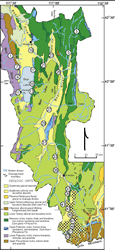
Introduction
This report describes magnetic minerals identified in lake sediments and watershed deposits of the lake-catchment system of Bear Lake, Utah, Idaho, and Wyoming. The lake sediments examined for this study came from the 1996 cores (BL96-1, -2, -3; Colman, 2005; Rosenbaum, 2005) and the GLAD800 cores (GLAD1-BL00-1D and -1E; Dean and others, 2002). The identification of magnetic minerals in these lake sediments provides important supporting information for paleoenvironmental and paleomagnetic interpretations, because different magnetic mineral types of vastly different origins, may in some cases, produce similar magnetic property signatures. For example, certain bulk magnetic properties from rock-derived detrital magnetite (Fe3O4) cannot be easily distinguished from properties imparted by postdepositional greigite (Fe3S4). Attention also was given to the possibility of postdepositional dissolution of detrital grains, such as magnetite, a common alteration in lake sediments under chemically reducing conditions (for example, Rosenbaum and others, 1996; also see Canfield and Berner, 1987). Petrographic analysis can be used to identify magnetic minerals, to determine the origins of these particles, and to recognize dissolution of detrital iron oxide minerals. In this way, we are able to distinguish between depositional and postdepositional magnetic signatures. Recognition of postdepositional alteration guides paleomagnetic interpretations and provides clues to lake-water chemistry.
Compositions of the detrital magnetic minerals, or rock fragments in which they are contained, additionally enable some interpretations regarding source areas for the lake sediments. Moreover, textures (size and shape) of the magnetic minerals in core samples may reflect erosional conditions and processes, such as glaciation, responsible for these minerals (Reynolds and others, 2004).
Properties of sediments in and near drainages within the watershed also provide valuable information for interpreting lake-sediment properties. For example, petrographic examination of watershed samples can reveal characteristics of the magnetic mineralogy, such as mineral type, size, and origin, that may be linked to the magnetic mineralogy and magnetic properties of lake sediments. This understanding further elucidates watershed processes and the sources of sediment that may change as a function of climate variability.
|
